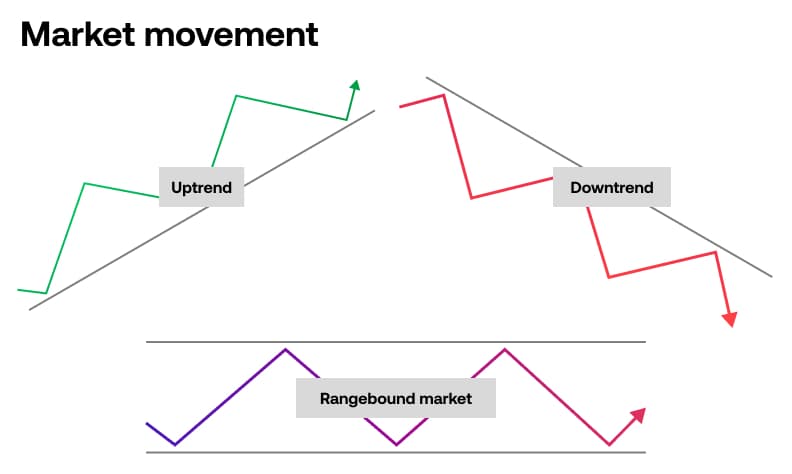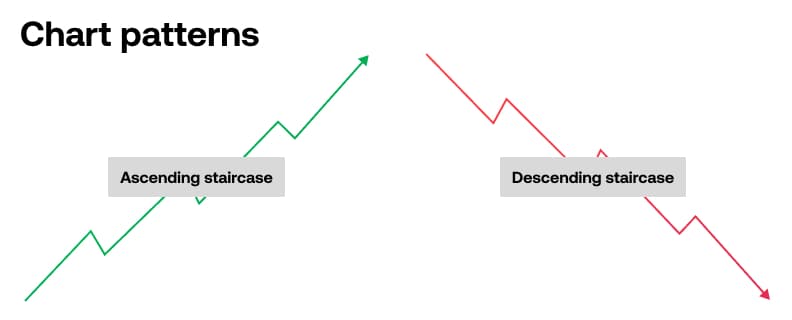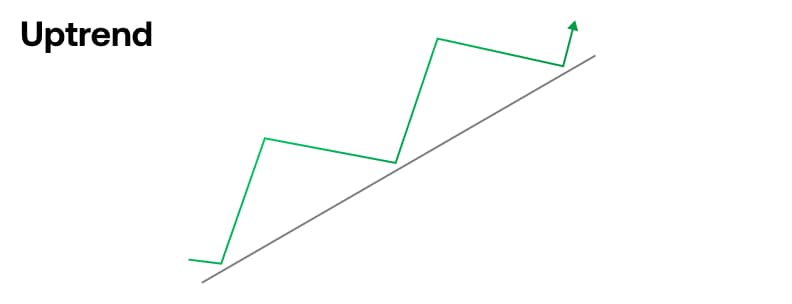
Technical analysis
Trading with the trend
What is a trend?
A trend has both movement and direction and markets can move in any of three directions:
- Upwards – considered as an uptrend and bullish
- Downwards – considered as a down trend and bearish
- Laterally – considered as range bound

As well as direction, the markets also have three trends:
- Major
- Intermediate
- Minor
A major or primary trend is considered the main trend over a longer period of time. This is the dominant direction of a market movement.
Within the major trend we can also have a secondary or intermediate trend and this is known as an intermediate trend.
Smaller movements which tend to last for very short periods of time are referred to as minor trends.
How to trade with trends
If a market has been bullish and heading higher followed by a move lower and then resumes its original direction, the move lower is the secondary trend whilst the move higher is the primary trend.
Minor trends typically last a very short period of time compared to the secondary trend. It is the minor trends where day traders attempt to capture smaller micro movements.
Therefore, from a time perspective, longer term traders look for primary trends to capture larger moves ranging from weeks to months. Intermediate term traders seek to capture secondary trends lasting from days to weeks and short term traders tend to look at minor trends ranging from hours to days.
When entering a trade it is important to know which direction the markets are currently trading in to offer a higher probability of successful trades. It is easy to think that being on the right side of the market should yield good results and although this sounds simple it can be difficult - especially for beginners - to enter a trade at the wrong phase of a trend.
Tools for trends
Some market technicians will say that trends can start without warning and can end abruptly. Others believe that using tools within technical analysis, a trader can at least benefit from observing chart patterns, using trend indicators such as moving averages and technical situations such as divergence.
A divergence is when markets are heading in an opposite direction relative to a technical indicator. More on this is covered in the indicators section.
Trend lines
One of the simplest tools to determine the direction of a market are trend lines.
Once you have a chart in place, to recognise if a market is in an uptrend or downtrend the use of trend lines can be applied. Chartists define trends on charts by drawing trend lines at angles. As mentioned earlier, there are three types of trends: uptrends, downtrends and sideways.
When the market is moving up or in an uptrend, the trend line will have a rising slope. This is achieved by joining two low points of a chart. The second low must be higher than the first low.
In a downtrend, the trend line would have a negative slope. By joining two highs together where the second high must be lower than the first high we would have a falling market.
At times when markets are stuck within a range we can also apply trend lines to both the highs and lows. This would create a channel and the market would appear to be stuck within a box.

Patterns
To see a direction of a trend traders can also use chart patterns, the two "classical" chart patterns used for trends are ascending and descending staircases.
From a chart pattern perspective, an uptrend can be considered when we have a series of higher highs and higher lows. This can be considered as a bullish trend. Traders will consider trading on the bullish side of the market until the uptrend comes to an end.
When markets are forming lower lows and lower highs this can be considered as a downtrend or often referred to as being bearish. In this phase traders would consider trading on the short side of the market.
In an uptrend a trader could buy the dips or the breakouts of recent highs. And in a downtrend a trader could sell the rallies or breakouts of recent lows.

Often markets may not trade in a trend and instead trade within a range or defined channel. This is where the market is unable to create a series of highs to the upside or a series of lows to the downside.
Some traders choose to sit on the side-lines during this phase and other traders would look to buy at the bottom of the channel and sell at the top whilst taking a short position on the top end of the channel and exiting at the bottom.
Indicators
Using indicators can also assist a trader in trading with the trend.
A popular indicator used by traders is the moving average and if used correctly can offer some good results when markets trend. But during times of consolidation both indicators and pattern failures can result in losses. This is why the use of money management and risk control is very important.
The use of indicators is covered in greater detail in the section; Trading with Indicators.
Did you know? A trend is always easier to see after it has been established. The objective is to try and capture a trend before it starts and exit before it ends. Trend traders aim to capture the majority of the move rather than the exact top or bottom.






